Keyword
A Keyword Campaign is a text message-based marketing strategy that allows businesses to engage mobile users through predefined keywords. Users send a keyword via SMS, WhatsApp, or RCS to a shortcode, long code, or phone number, triggering an automated response.
Short-code (4-6 digits): Used for promotions, alerts, and two-factor authentication. Short codes are used exclusively with SMS messages and most often used by companies for:
- Marketing promotions: To send ads, coupons, sales alerts, and other promotional information. If you are based out of the US, it is mandatory to have a short code to send marketing texts.
- Two-factor authentication: This is because a message sent via an SMS short code is likely to be delivered quicker.
For example:
Send ‘Mammoth’ to 12345 and receive an alert for Mammoth Resort.
Keyword : Mammoth
Short-code: 12345
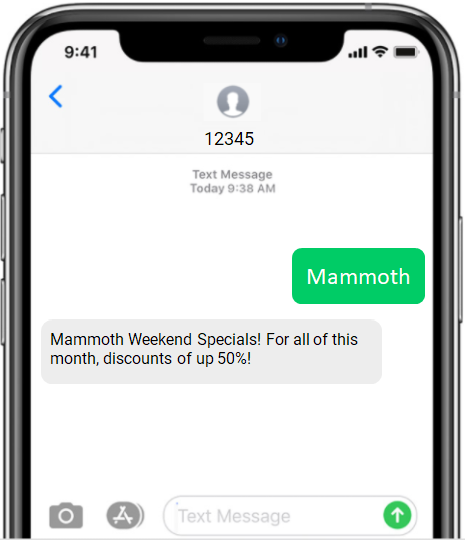
Long code (10 digits): A long code number is a standard phone number used to send and receive voice calls and text messages. Phone numbers are typically called “long codes” (10-digit numbers in many countries). Typically, a long code is used by courier companies, banks, airlines, and other service sectors for customer service-related communication. Here are some popular use cases:
- A courier company could use a long code to inform a customer that their package is out for delivery.
- A bank could text clients their account balance every month.
- An airline can reply to a passenger’s seat preference request.
Keyword campaigns easily engage potential customers with targeted offers and deliver information straight to their mobile device via mass text messaging.
The setup of Keyword Campaigns consists of three steps:

- Delivery
- Keyword
- Summary
Delivery
You define the Delivery Channel and the campaign Recipients in the Delivery step.
Currently, three delivery channels are available for the Keyword campaign:
For more information on selecting the desired delivery channel, go to the Delivery section.
Keyword
In this step, you create interactions with customers based on a set of predefined keywords and associated response messages and add webhooks to each interaction so that you can track how far into your campaign participants are willing to go in response to the messages they are receiving.
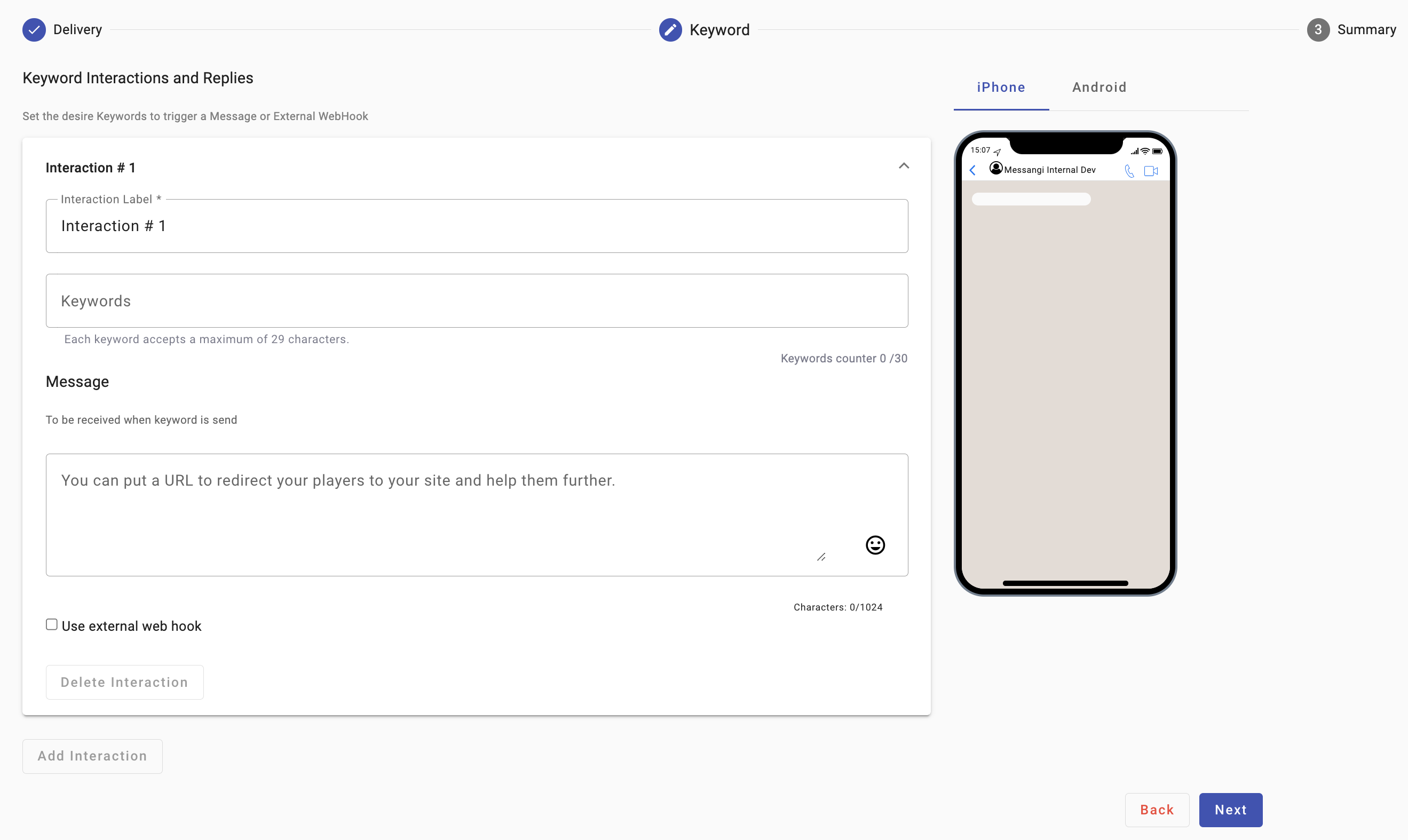
The steps to create interactions involve:
- The definition of the interaction, which includes keyword reception and the ensuing message, and
- Event triggering capabilities via webhooks
-
Interaction Label: First, enter the name of the Interaction in the Interaction Label text field. This identifies each interaction you create. Example: FreeTrialOffer or NewsletterSignup.
-
Keywords: Enter the keywords that will trigger an automated response for this interaction. You can add one or more keywords to a given interaction, as several keywords associated with a given interaction will allow you to determine from which element in your campaign are arriving more or less interactions.
Try to keep the keywords short, simple, and relevant to your campaign. For example, a keyword campaign for a free trial of your service could use the keyword TRIAL. Avoid the use of special characters such as !, @, #, and $, which could confuse at the moment of entering them.
Keywords are not case sensitive, so Trial and TRIAL are equivalent, and keywords used in other Keyword campaigns will be highlighted in red as shown below for the case of TRIAL. That is, Keywords must be unique within a campaign. If TRIAL is used in one campaign, it cannot be reused in another campaign for the same shortcode.
 NOTE
NOTEA keyword and its corresponding platform engagement entity are unique. For example, say the 12345 shortcode is being used in a campaign with the keyword "TRIAL". Creating a different campaign with the shortcode 12345 and the "TRIAL" keyword would create a conflict with the existing campaign. Hence, this condition is not allowed.
You can have up to 30 keywords, and each keyword accepts up to 29 characters. To keep track of the number of keywords in use, at the bottom right corner of the Keywords section is a keyword counter.
The Message section will be aligned with the channel type used in the campaign, SMS, RCS, or WhatsApp, and with the features allowed in each of them.
The Keyword Campaign supports the use of regular expressions (regex), enabling more flexible and intelligent input validation for user interactions.
This advanced functionality allows you to define keyword patterns that match a variety of text inputs—ideal for use cases where customer input must follow a specific format, such as an ID number, phone number, or other structured value.
Example: Validating a National ID Format
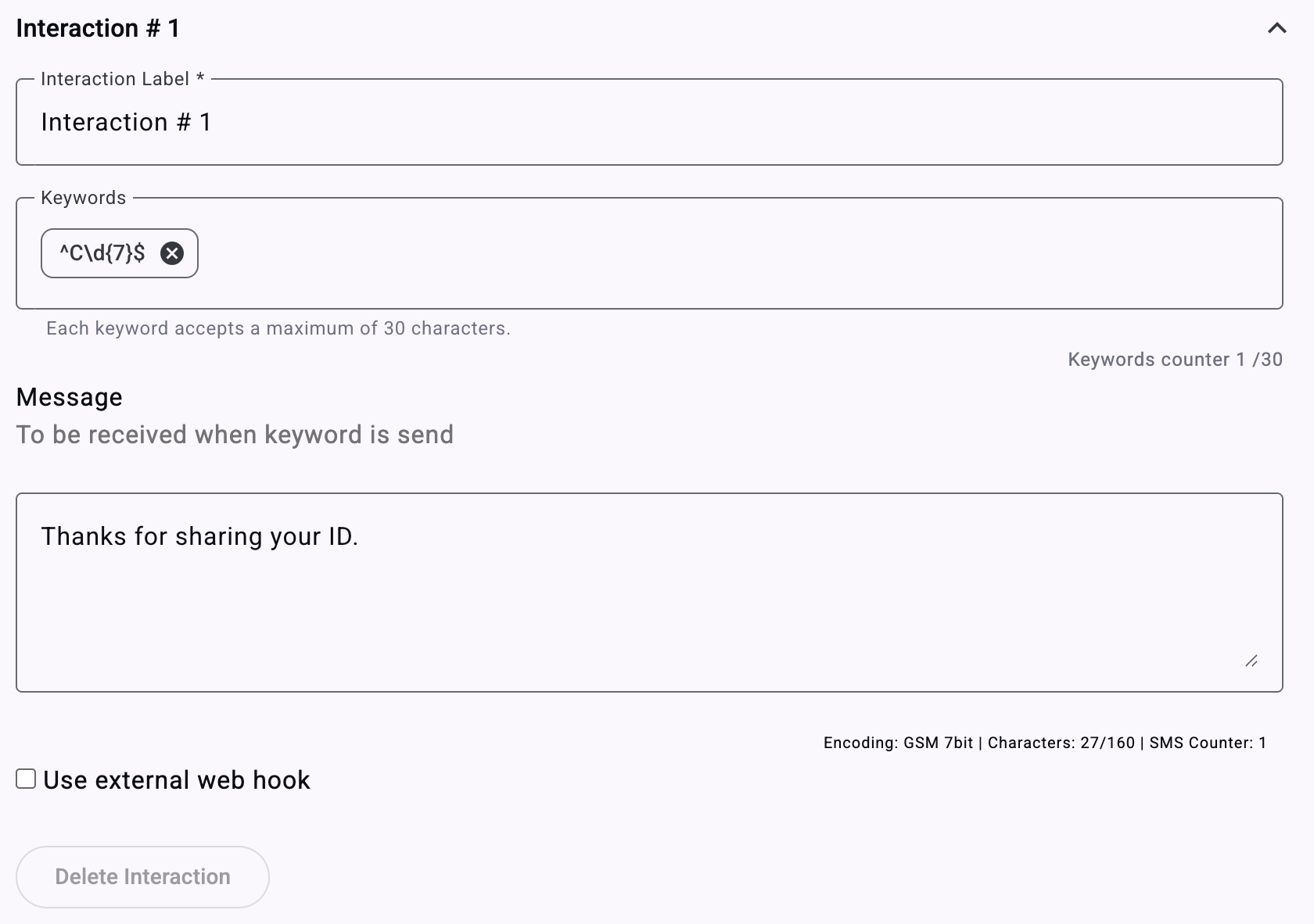
Suppose you want users to submit their national ID as part of a keyword interaction. The required format is that the ID must start with the letter "C" (uppercase only), followed by seven digits. You can achieve this using a regular expression.
Regular Expression ->
^C\d{7}$This regex can be used in the Keywords field to validating the following structure:
^ensures the input starts with..Cthe uppercase letter C.\d{7}exactly seven numeric digits.$ensures the input ends there (no extra characters).
Therefore, the input starts with C, followed by seven digits. When a user sends a message matching this format, the campaign is triggered, and the user receives a predefined message such as: "Thanks for sharing your ID."
-
If the user’s input matches the regular expression, the system enters the campaign flow and delivers the configured response.
-
If the input does not match, the system ignores the message, and no interaction is triggered.\
NOTEEach keyword or regular expression is limited to 30 characters. Ensure your pattern is optimized and concise.
-
Message: Enter the response message that users will receive after texting a keyword.
For example, to add customers to your subscription list to deliver deals and news about products or discounts, you can create a campaign that includes the JOIN keyword as an invitation to subscribe that will result in the following feedback message:

Which will result in the following at the participants' end, upon reception of the keyword JOIN.
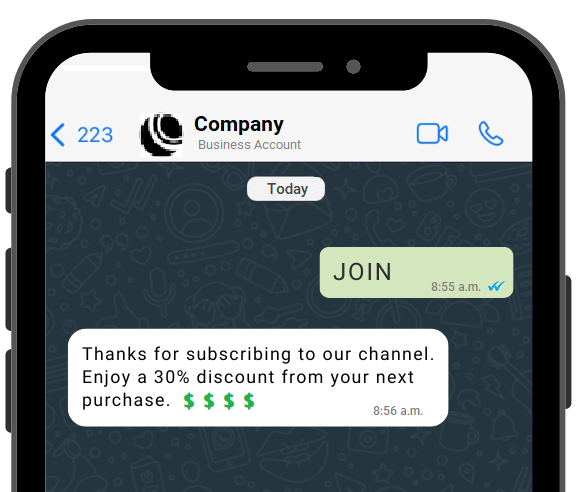
You can include a trigger event in your application by defining a webhook.
The Response Message supports Markdown syntax, allowing you to format the text for a more engaging and clear presentation. You can use basic Markdown options such as bold, italics, strikethrough, and monospace to enhance the readability and impact of the message.
Markdown syntaxMarkdown syntax is a powerful tool that can help you make your messages stand out and capture the attention of your recipients. You can create visually appealing and easy-to-understand messages. making your messages more readable. In the world of short attention spans, properly formatted messages can help ensure that your content is understood and remembered. Therefore, markdown is a lightweight markup language that you can use to add formatting elements to plain text text.
WhatsApp only supports a limited set of basic formatting options, such as bold, italics, strikethrough, and monospace:
- Bold Text: To make text bold, place asterisks
*around the text. (e.g.,*this text is bold*). - Italic Text: To italicize text, use underscores
_around the text. (e.g.,_this text is italic_). - Strikethrough Text: To strike through text, place tildes
~around the text. (e.g.,~this text is Strikethrough~). - Monospaced Text: To display text in a monospaced (fixed-width) font, use three backticks (
```) around the text. (e.g.,```this text is Monospaced```).
Markdown syntax is supported exclusively for WhatsApp messages and is not available for SMS and RCS.
- Bold Text: To make text bold, place asterisks
-
Use external webhook: Select the webhook checkbox to register the interaction event to your application in real time. That is, the webhook allows you to forward data to your application for further processing.
NOTEif you opt for WhatsApp as delivery channel and set a Webhook URL go to the Keyword (Webhook WhatsApp) section to know the data displayed on the JSON Payloads that is sent from the platform to your webhook URL.
-
Webhook name: The first step to set up the webhook is to give it a name.
-
POST Method: The platform offers the
POSTmethod as the de facto option from the dropdown method menu, a practice of any webhook configuration that allows the transfer of information of a web-based app to another. -
Webhook URL: The next step is to enter the webhook URL where the data will be received. That is, the data is sent from the platform to a webhook URL, which should be set up to handle the contents provided in the payload.
For example, each user who sends the TRIAL keyword will generate an event that will be sent to the webhook URL handler in your application. Your webhook URL will receive the information in JSON format as follows:
{ "date": "2020-10-22T20:29:57.453673Z", "owner": "[email protected]", "origin": "8641", "callback": "http://www.mycallback.com/", "externalId": 8, "id": "1abc2def3ghi4jkl", "text": "TRIAL", "user": "+580000000005" }Inspired by the format used by JavaScript to declare objects — collections of keys and values like, for example, “text”: “TRIAL”.
Key Value date User participation date. The date is represented in UTC timezone. owner Campaign owner. origin Code where the user comes from. callback Signature of the invoked method. externalId Process identifier. id User identifier generated from the operator. text Keyword the user sent to participate in the campaign. user User mobile number who participated in the campaign. The information provided includes the keyword that triggered the event as well as the user's number that can be used to keep track of users who interacted with the campaign and that may have opted-in temporarily for this campaign by sending the TRIAL keyword.
-
-
Add Interaction: If you want to add another Interaction, select Add Interaction button located at the end of the interaction.
NOTEThere are no limits to the number of Interactions you can add to a campaign.
-
Delete Interaction: To delete an interaction, select Delete Interaction immediately under the external webhook checkmark.
Once the Keyword Configuration step is complete, select Next to proceed to the Summary step.
Summary
The Summary step provides an overview of the campaign settings before activation..
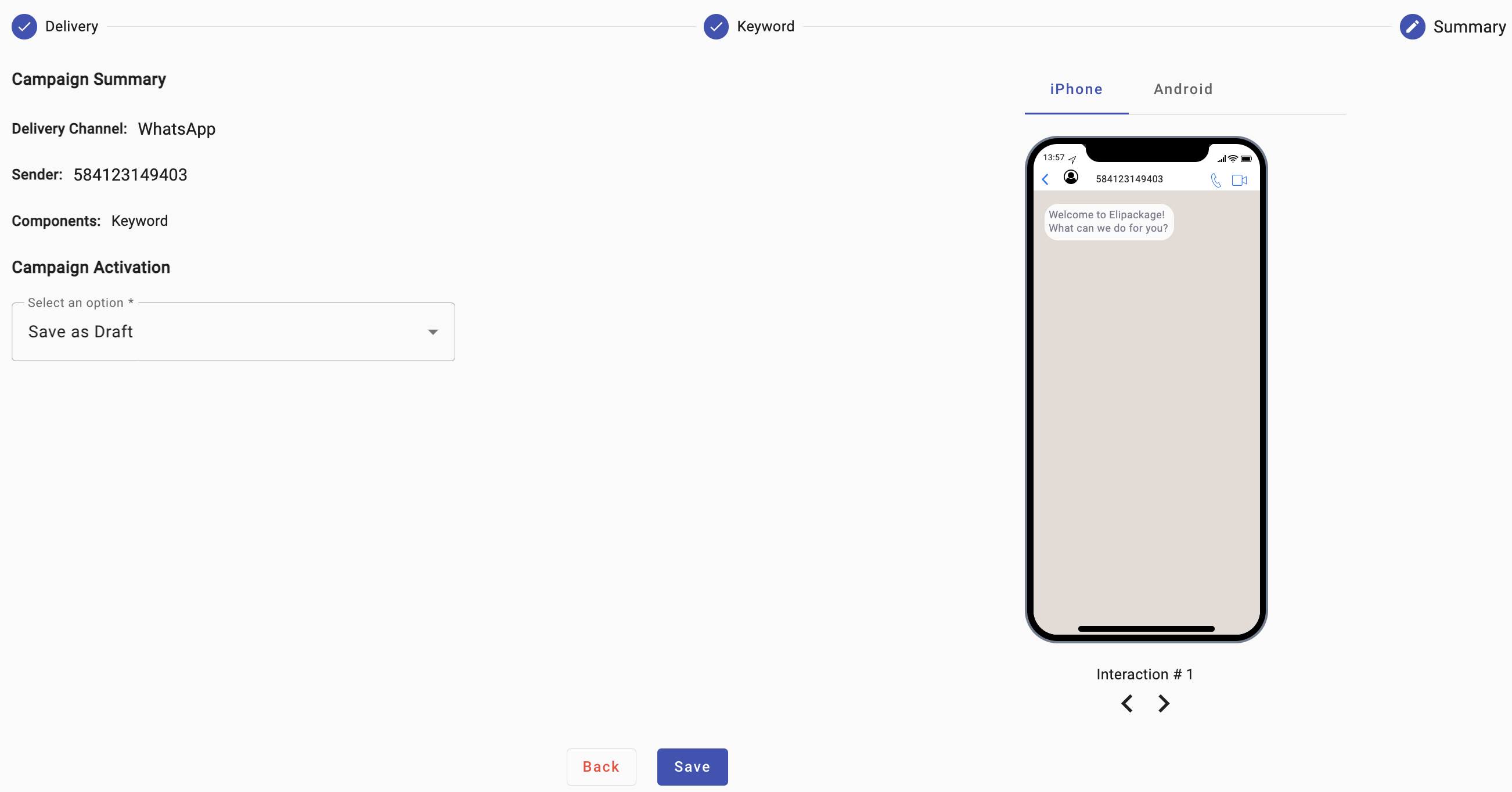
The summary step consists of the following elements:
- Delivery Channel: Type of channel (SMS, WhatsApp) through which the campaign was sent.
- Sender: According to the sender type selected during campaign setup, it is used as the sender of the notification message.
Remember, each delivery channel has its sender type ( Sender number Send, Sender WhatsApp Business Account App], RCS , RCS ] ).- ).
- Components: Type of components of which the interactive campaign is composed: Campaign type.
- Campaign Activation: Set the campaign delivery date (Live [Available if you set as delivery channel the SMS WhatsApp or RCS ), Save as Draft).
For more information about the Summary step settings, go to Summary in the Campaign Elements section.
Updated 2 days ago
